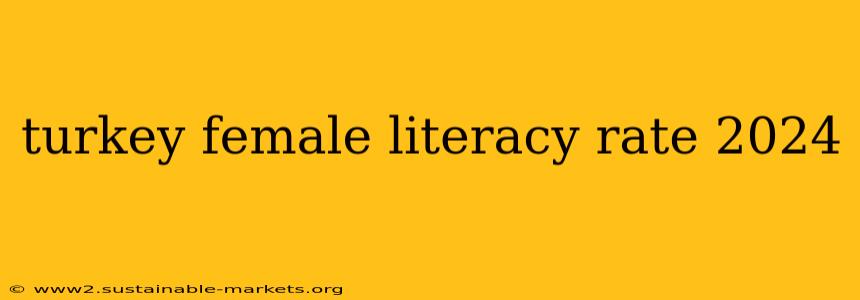The literacy rate for women in Turkey is a complex issue reflecting broader societal changes and government initiatives. While significant progress has been made in recent decades, challenges remain in achieving complete gender equality in education. Pinpointing an exact, officially released figure for 2024 specifically requires waiting for official data releases from Turkish statistical agencies like TurkStat (Türkiye İstatistik Kurumu). However, we can analyze the trends and factors influencing the rate to provide a well-informed perspective.
Understanding Turkey's Literacy Landscape
Literacy rates are typically measured as the percentage of the adult population (usually defined as those aged 15 and above) who can read and write with understanding. Turkey has witnessed a substantial increase in overall literacy rates over the past few decades, benefiting both men and women. However, a gender gap persists, with female literacy rates historically lagging behind those of males.
Historical Context and Progress
Turkey has implemented various educational reforms and programs aimed at improving female literacy. These include expanding access to primary and secondary education, particularly in rural areas, and promoting girls' education through targeted initiatives. The success of these programs is evident in the steady rise of female literacy over the years. While precise year-by-year data for 2024 is unavailable at the time of writing, the overall trend indicates continued, albeit potentially uneven, improvement.
Factors Influencing Female Literacy Rates in Turkey
Several interconnected factors contribute to the current state and future trajectory of female literacy in Turkey:
1. Socioeconomic Factors:
- Poverty: Poverty often correlates with lower educational attainment, particularly for girls. Families facing economic hardship may prioritize boys' education over girls', leading to higher dropout rates for girls.
- Rural vs. Urban Divide: Access to quality education is often better in urban areas compared to rural regions. This disparity affects girls disproportionately, as many rural areas have limited educational infrastructure and resources.
2. Cultural and Social Norms:
- Traditional Gender Roles: Traditional gender roles and expectations can sometimes limit girls' opportunities for education. Early marriages and household responsibilities often interfere with school attendance.
- Attitudes towards Female Education: While attitudes are gradually changing, some communities may still undervalue the importance of female education.
3. Government Policies and Initiatives:
- Educational Reforms: Government policies and initiatives aimed at improving access to education and promoting gender equality play a crucial role.
- Investment in Education: Increased investment in education infrastructure, teacher training, and educational resources is essential for enhancing literacy rates.
Challenges and Future Directions
Despite progress, challenges remain in bridging the gender gap in literacy:
- Ensuring equitable access to quality education: This requires addressing socioeconomic disparities and improving educational infrastructure in underserved areas.
- Challenging traditional attitudes: Public awareness campaigns and community engagement initiatives can help change attitudes toward female education.
- Supporting girls' education beyond primary school: Retention rates for girls in secondary and higher education need improvement.
Conclusion: Looking Ahead
While the precise female literacy rate for Turkey in 2024 awaits official data release, the trajectory suggests continued improvement. However, sustaining this progress and achieving complete gender parity requires a multi-faceted approach addressing socioeconomic factors, cultural norms, and the ongoing commitment of the Turkish government to invest in and support girls' education. Continued monitoring of literacy rates and the implementation of targeted interventions will be crucial for tracking progress and ensuring that all girls and women in Turkey have the opportunity to achieve their full potential through education.

